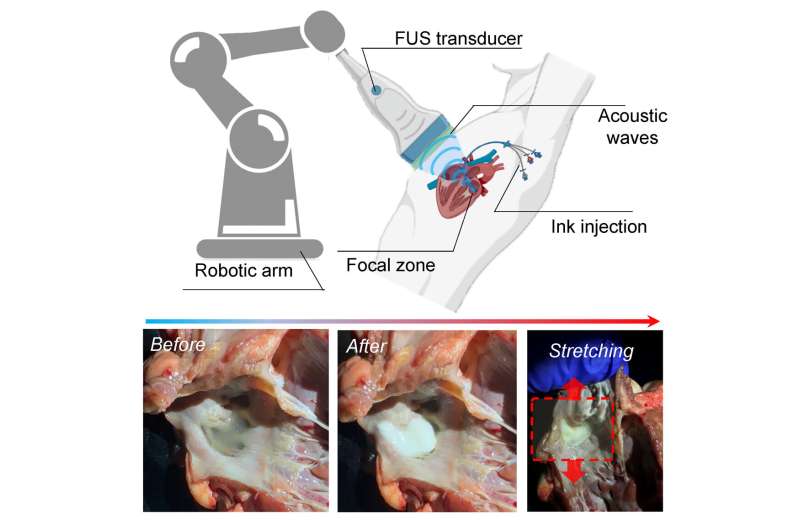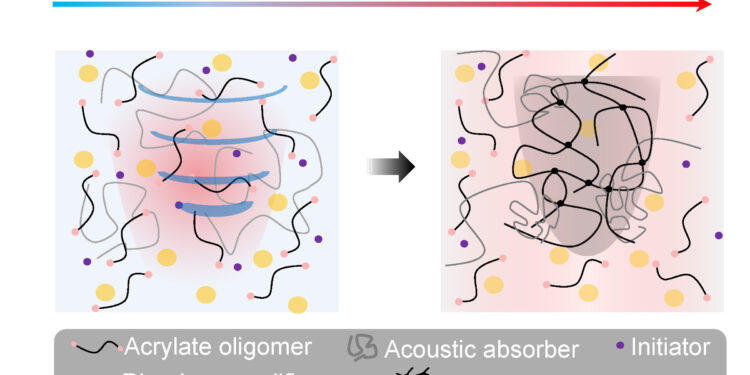DAVP prints 3D constructions by curing sound inks with focused ultrasound waves. The sonothermal effect triggers the decomposition of the sonoinks to form polymer networks at the focal zone of the ultrasound. Credit: Junjie Yao, Duke University; Shrike Yu Zhang, Harvard Medical School.
Engineers from Duke University and Harvard Medical School have developed a biocompatible ink that solidifies into different 3D shapes and structures by absorbing ultrasound waves. Because it responds to sound waves rather than light, the ink can be used in deep tissues for biomedical purposes ranging from bone healing to heart valve repair.
This work appears in the journal Science.
The uses of 3D printing tools continue to grow. Printers create prototypes of medical devices, design flexible and lightweight electronic components, and even manufacture tissues used in wound healing. However, many of these printing techniques involve building the object point by point in a slow and arduous process that often requires a robust printing platform.
To get around these problems, researchers in recent years have developed a photosensitive ink that responds directly to targeted beams of light and quickly hardens to form the desired structure. Although this printing technique can significantly improve the speed and quality of a print, researchers can only use transparent inks for prints, and biomedical purposes are limited because light cannot penetrate beyond a few millimeters deep in the tissues.
Now, Y. Shrike Zhang, associate bioengineer at Brigham and Women’s Hospital and associate professor at Harvard Medical School, and Junjie Yao, associate professor of biomedical engineering at Duke, have developed a new printing method called acoustic volumetric printing at deep penetration, or DVAP. , this solves these problems.
This new technique uses specialized ink that reacts to sound waves rather than light, allowing them to create biomedically useful structures at unprecedented tissue depths.
“DVAP relies on the sonothermal effect, which occurs when sound waves are absorbed and increase the temperature to harden our ink,” explained Yao, who designed the ultrasonic printing technology for DVAP. “Ultrasound waves can penetrate more than 100 times deeper than light while remaining spatially confined, allowing us to reach tissues, bones and organs with high spatial precision that have not previously been accessible with light-based printing methods.”
The first component of DVAP involves a sonic ink, called sono-ink, which is a combination of hydrogels, microparticles and molecules designed to respond specifically to ultrasound waves. Once the sono ink is delivered to the target area, a specialized ultrasonic printing probe sends focused ultrasonic waves into the ink, hardening parts of it into complex structures.
These structures can range from a hexagonal scaffold that mimics the hardness of bones to a hydrogel bubble that can be placed on an organ.

In this example, DAVP is used to close the left atrial appendage (LAA) in a goat heart, which can reduce the risk of blood clots forming inside the heart. The printed construction conforms to the heart wall and is highly stretchable. DAVP does not need to open the chest for such heart surgery. Credit: Junjie Yao, Duke University; Shrike Yu Zhang, Harvard Medical School
“The ink itself is a viscous liquid, so it can be injected into a targeted area quite easily, and as you move the ultrasonic printing probe, the materials in the ink bind and harden,” he said. said Zhang, who designed the sound system. -ink in his laboratory at the Brigham. “Once this is done, you can remove any remaining ink that is not solidified using a syringe.”
The different components of sono ink allow researchers to adapt the formula for a wide variety of uses. For example, if they want to create a scaffold to help heal a broken bone or compensate for bone loss, they can add bone mineral particles to the ink. This flexibility also allows them to design the cured formula to be more durable or more degradable, depending on its use. They can even adjust the colors of their final print.
The team conducted three tests as proof of concept of their new technique. The first involved using ink to seal a section of a goat’s heart. When a human suffers from non-valvular atrial fibrillation, the heart does not beat properly, causing blood to build up in the organ. Traditional treatment often requires open chest surgery to seal the left atrial appendage to reduce the risk of blood clots and heart attack.
Instead, the team used a catheter to deliver their sound ink to the left atrial appendage of a goat heart placed in a printing chamber. The ultrasound probe then delivered focused ultrasound waves through 12mm of tissue, hardening the ink without damaging surrounding organs. Once the process was complete, the ink was safely bonded to the heart tissue and was flexible enough to withstand movements mimicking the heartbeat.
Next, the team tested the potential of using DVAP for tissue reconstruction and regeneration. After creating a bone defect model using a chicken leg, the team injected the sono ink and cured it through 10mm of skin and muscle tissue layer samples. The resulting material bonded perfectly to the bone and had no negative impact on the surrounding tissues.
Finally, Yao and Zhang showed that DVAP could also be used for therapeutic drug delivery. In their example, they added a common chemotherapy drug to their ink, which they administered to collect liver tissue samples. Using their probe, they hardened the sono ink into hydrogels that slowly released the chemotherapy and diffused into the liver tissue.

Hardened Sono-Ink (appearing red) in a heart model. DAVP prints 3D constructions by curing sound inks with focused ultrasound waves. Credit: Alex Sanchez, Duke University; Junjie Yao, Duke University; Y. Shrike Zhang, Harvard Medical School
“We are still a long way from bringing this tool into the clinic, but these tests have reaffirmed the potential of this technology,” Zhang said. “We’re very excited to see where this can take us from here.”
“As we can print through tissue, this allows for many potential applications in surgery and therapy that traditionally involve very invasive and disruptive methods,” Yao said. “This work opens an exciting new path in the world of 3D printing, and we are excited to explore the potential of this tool together.”
More information:
Xiao Kuang et al, Self-enhanced sound inks enable deep penetration acoustic volumetric printing, Science (2023). DOI: 10.1126/science.adi1563. www.science.org/doi/10.1126/science.adi1563
Provided by Duke University
Quote: Sound waves harden 3D printed treatments in deep tissues (December 7, 2023) retrieved December 7, 2023 from
This document is subject to copyright. Apart from fair use for private study or research purposes, no part may be reproduced without written permission. The content is provided for information only.



